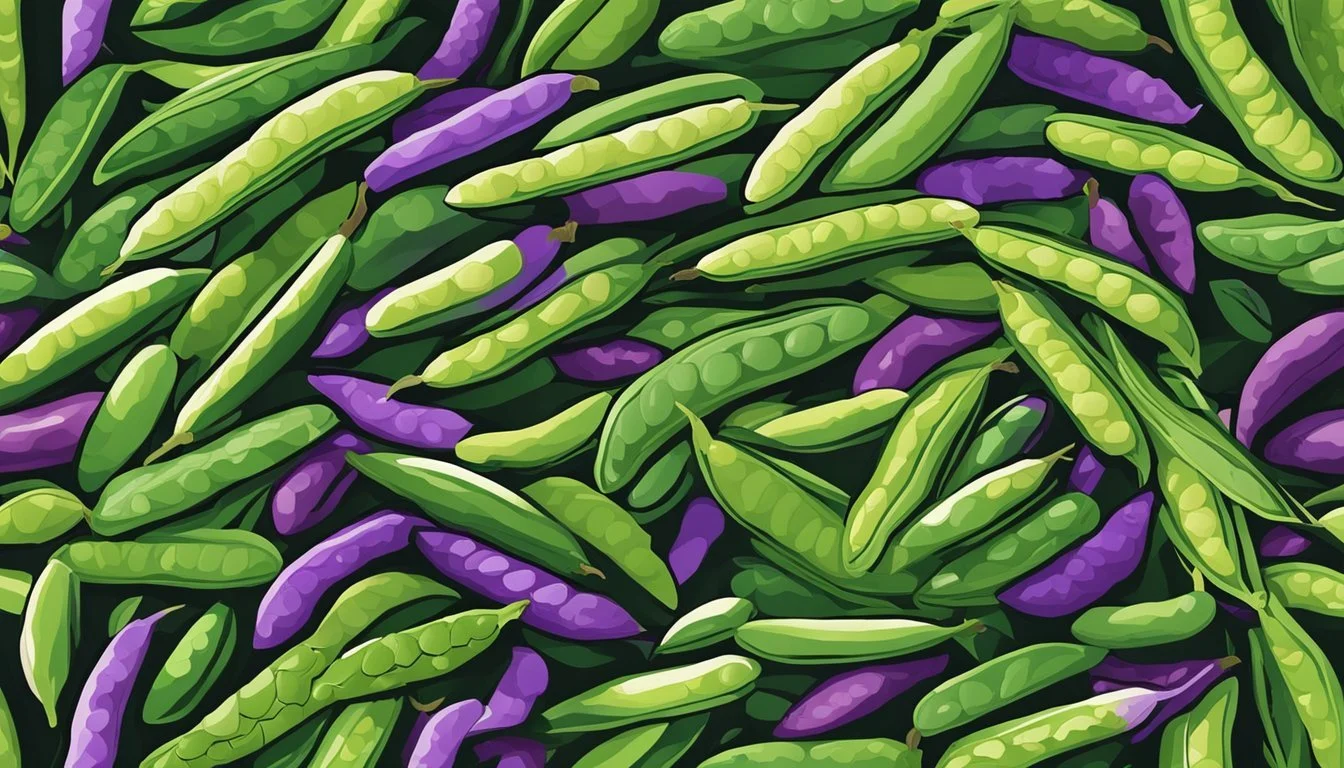Dragon Tongue Beans Substitutes
Best Alternatives for Recipes
Dragon Tongue beans, an heirloom variety, are celebrated for their unique appearance and delightful flavor. These beans, with their elongated, dark green pods marked by purple streaks, not only stand out visually but also offer a sweet, nutty taste that enhances many dishes. If you're unable to find Dragon Tongue beans, viable substitutes include green beans, wax beans, or Romano beans, each providing a similar crunchy texture and mild flavor.
For those aiming to replicate the distinctive taste and texture, green beans are often the go-to substitute due to their widespread availability and versatile use. Wax beans, another excellent choice, offer a similar crunch and can seamlessly replace Dragon Tongue beans in most recipes. Adding to the options, Romano beans bring a broader, flat shape to the table, closely mimicking the texture and culinary applications of Dragon Tongue beans.
Experimenting with these substitutes can still yield remarkable dishes, whether sautéed with garlic, added to salads, or incorporated into stews. By choosing any of these alternatives, you ensure that your culinary creations maintain their delightful flavor and appeal, even when Dragon Tongue beans are out of reach.
Understanding Dragon Tongue Beans
Dragon tongue beans (Phaseolus vulgaris) are a Dutch heirloom variety known for their aesthetic appeal, nutritional benefits, and culinary versatility. They are easily identifiable by their distinctive coloring and offer a tender, sweet flavor that enhances both fresh and cooked dishes.
Characteristics and Growth
Dragon tongue beans belong to the Fabaceae family. The plants produce flat, oval pods that are typically 6-8 inches long.
These pods feature striking purple stripes on a creamy yellow background. As a bush variety, they are easy to grow, requiring minimal support.
They thrive in warm, well-drained soil and need full sun for optimal growth. An essential feature of dragon tongue beans is their color change; the pods turn solid yellow when cooked. Harvesting can be done early for fresh beans or allowed to dry on the vine for storage.
Culinary Uses
Dragon tongue beans are versatile in the kitchen. Fresh pods can be eaten raw, adding a tender, sweet crunch to salads and vegetable platters.
When cooked, they maintain a buttery texture and unique flavor. They are excellent in stir-fries, soups, and stews. Blanching and steaming are common methods to prepare them.
These beans also shine in pickling recipes due to their ability to retain texture. For long-term storage, they can be dried or frozen, enabling year-round enjoyment.
Nutritional Profile
Dragon tongue beans are nutrient-dense, offering various health benefits. They are rich in protein, fiber, and essential vitamins and minerals.
Key nutrients include vitamins A, C, and K, along with folate and potassium. The high fiber content supports digestive health, while the protein aids in muscle maintenance and repair.
Additionally, these beans provide antioxidants, which help combat free radicals in the body. Their nutritional profile makes them an excellent addition to a balanced diet.
Cultivation Tips
Growing Dragon Tongue Beans successfully involves understanding their specific planting requirements, ongoing maintenance, and proper harvesting techniques. Attention to these details can result in a bountiful and healthy crop.
Planting Requirements
Dragon Tongue Beans thrive in full sun and should be planted in well-drained soil enriched with plenty of organic matter. They are often directly sown once soil temperatures reach at least 60°F (15°C). The seeds should be planted about 1 inch deep and spaced 3 inches apart.
For regions in southern zones, early planting is possible, but ensure the risk of frost has passed. These beans don't need much support due to their bush habit but ensure they have space to spread.
Maintenance and Care
Maintaining Dragon Tongue Beans involves regular watering, particularly during dry periods, while avoiding waterlogging. They benefit from a layer of mulch to maintain moisture and control weeds.
Once established, they require little feeding as they are nitrogen fixers, which improve soil fertility on their own. Be vigilant for pests such as aphids and beetles, and use organic pest control methods if necessary.
Harvesting and Storage
Harvest Dragon Tongue Beans when the pods are about 4-6 inches long and still tender. They can be harvested continuously as they mature, promoting further production.
Post-harvest, an ice bath can help maintain their vibrant color and crisp texture if storage is required. For long-term storage, consider freezing the blanched beans. Fresh beans are best stored in a cool, dry place, making them a great choice for farmers' markets or home gardens.
Proposed Substitutes for Dragon Tongue Beans
When looking for alternatives to Dragon Tongue beans, consider beans with a similar flavor and texture profile or entirely different vegetables that can serve a similar purpose in a recipe.
Similar Legume Varieties
Green Beans are a versatile substitute, offering a tender crispiness when cooked. They share a similar texture and mild flavor, making them a practical replacement in salads, stir-fries, and sautés.
Dragon Tongue Bush Beans can closely mimic the texture and unique flavor of Dragon Tongue beans. They are often similarly spotted and can be used in recipes requiring a bit of crunch and nutty sweetness.
Black Beans provide a distinctly different flavor but can work well in dishes requiring a rich, earthy taste. These are best suited for stews, soups, and bean salads where their deep flavor complements other ingredients.
Non-Legume Substitutes
Asparagus provides a crisp texture and mild flavor similar to Dragon Tongue beans. It works well roasted, grilled, or steamed and can be a great addition to various dishes.
Zucchini can be sliced or diced and used in place of Dragon Tongue beans. Its mild flavor makes it a versatile substitute in sautés, stir-fries, and baked dishes.
Snap Peas offer a sweet, crunchy alternative. They can be used raw in salads or cooked lightly, making them suitable for various recipes that require Dragon Tongue beans' texture and sweetness.
These substitutes offer flexibility in cooking while ensuring dishes remain flavorful and enjoyable.
Cooking with Dragon Tongue Beans
Dragon tongue beans are versatile and can be used in many ways. They’re excellent for both raw preparations and cooked dishes, bringing a unique texture and flavor to any meal.
Preparation Methods
Blanching: To blanch dragon tongue beans, bring a medium-sized pot of salted water to a boil. Add the beans and blanch them for about 3-5 minutes until they are tender but crisp. Drain and immediately run under cold water to stop the cooking process.
Steaming: Steaming helps preserve the beans' nutrients. Place them in a steamer basket over boiling water for about 5-7 minutes.
Sautéing: Heat olive oil or extra virgin olive oil in a skillet over medium heat. Add the beans and cook for about 5 minutes, adding garlic and herbs for an extra burst of flavor.
Popular Recipes
Warm Salad: Combine blanched beans with cherry tomatoes, bell peppers, and a lemon vinaigrette. The beans' sweetness pairs well with the tangy dressing and the freshness of summer vegetables.
Stir Fry: Stir fry with garlic, peppers, and a touch of soy sauce. Their nutty flavor and stringless quality make them ideal for this preparation.
Pasta Dish: Add beans to a pasta dish with pancetta, mushrooms, and a dash of black pepper. The pancetta's crispiness complements the beans' tender texture.
Pickled Beans: Pickling is another popular method. Simply prepare a brine with vinegar, water, and salt. Add garlic, dill, or other herbs, and refrigerate the beans for a couple of days.
Preservation Techniques
Freezing: To freeze dragon tongue beans, blanch first, then let them cool, and dry thoroughly. Place them in airtight containers or freezer bags. They can be used later in various cooked dishes.
Pickling: Pickling helps preserve their crisp texture and nutty flavor. Submerge the beans in a seasoned brine and refrigerate. They make a great addition to salads or antipasto platters.
Drying and Shelled Beans: Mature beans can be shelled and dried. Store them in a cool, dry place. They can be later rehydrated and used in soups or stews.
By using these methods, one can enjoy the unique taste and texture of dragon tongue beans throughout the year.
Pests and Diseases Management
Effective management of pests and diseases is crucial for maintaining the health and productivity of Dragon Tongue beans. Key strategies include diligent monitoring, early intervention, and the use of organic treatments to minimize damage and preserve the plants.
Common Pests
Dragon Tongue beans are susceptible to a variety of pests, including aphids and Mexican bean beetles. Aphids are small, sap-sucking insects that can weaken plants by drawing out vital nutrients, leading to yellowing and curling leaves. A strong spray of water can dislodge them, while insecticidal soap and neem oil offer effective control.
Mexican bean beetles are another common pest. These beetles, resembling ladybugs but typically yellow with black spots, can cause severe defoliation. Handpicking the beetles and their yellow, spiny larvae off the plants can help reduce their population. Introducing beneficial insects such as lady beetles and parasitic wasps can also aid in controlling these pests.
Disease Prevention
Dragon Tongue beans can be affected by diseases such as bacterial blight and powdery mildew. These diseases can weaken plants, reduce yields, and ultimately kill the plants if left untreated. To prevent bacterial blight, avoid overhead watering and ensure good air circulation around the plants.
To manage powdery mildew, look for white, powdery spots on leaves and stems and remove affected foliage immediately. A mixture of baking soda and water can be sprayed onto plants as an effective treatment. Rotating crops and planting disease-resistant varieties when possible can also help reduce the risk of disease.
By implementing these pest and disease management strategies, gardeners can maintain the health and productivity of their Dragon Tongue bean plants.
Health Benefits and Dietary Considerations
Dragon Tongue beans are not only delicious but also packed with nutritional benefits. They provide a range of essential vitamins, minerals, and other nutrients.
Rich in fiber, these beans aid in digestion and help maintain a healthy gut. Fiber can also play a role in managing weight by promoting a sense of fullness.
Dragon Tongue beans are an excellent source of protein, making them a valuable addition to plant-based diets. Protein is important for muscle growth and tissue repair.
The beans contain a variety of minerals such as magnesium, potassium, and calcium, which are key for bone health and metabolic functions.
These beans are also rich in antioxidants, which protect cells from damage by free radicals. This helps reduce the risk of chronic diseases like heart disease and may enhance overall health.
Including Dragon Tongue beans in the diet can support a healthy immune system due to the presence of essential vitamins such as Vitamin C and B-complex vitamins.
Here’s a quick overview of their nutritional benefits:
Nutrient Benefits Fiber Aids digestion, supports gut health Protein Supports muscle growth, tissue repair Minerals Bone health, metabolic functions Antioxidants Protects cells, reduces chronic disease risk Vitamins Immune health, overall wellbeing
Incorporating Dragon Tongue beans into various meals can help provide these essential nutrients, contributing to a balanced and healthful diet.





